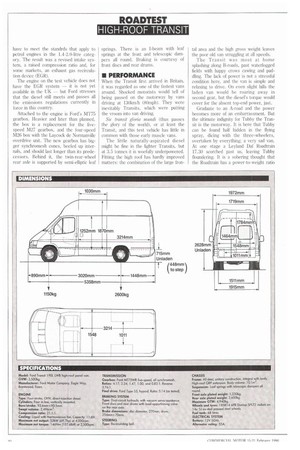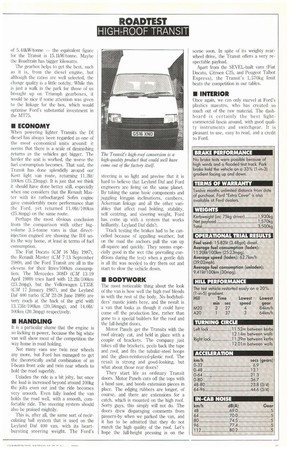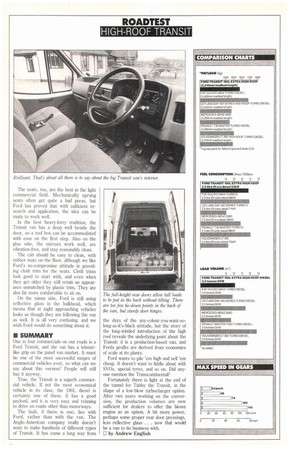ROADTEST HIGH-ROOF TRANSIT
Page 42

Page 43

Page 44

If you've noticed an error in this article please click here to report it so we can fix it.
have to meet the standrds that apply to petrol engines in the L4-2.0-litre category. The result was a revised intake system, a raised compression ratio and, for some markets, an exhaust gas recirculation device (EGR).
The engine on the test vehicle does not have the EGR system — it is not yet available in the UK — but Ford stresses that the diesel still meets and passes all the emissions regulations currently in force in this country.
Attached to the engine is Ford's MT75 gearbox. Heavier and later than planned, the box is a replacement for the fivespeed M27 gearbox, and the four-speed M26 box with the Laycock de Normanville overdrive unit. The new gearbox has bigger synchromesh cones, beefed up internals, and should last longer than its predecessors. Behind it, the twin-rear-wheel rear axle is supported by semi-elliptic leaf springs. There is an I-beam with leaf springs at the front and telescopic dampers all round. Braking is courtesy of front discs and rear drums.
When the Transit first arrived in Britain, it was regarded as one of the fastest vans around. Shocked motorists would tell of being passed on the motorway by vans driving at 130km,fh (80mph). They were inevitably Transits, which were putting the vroom into van driving.
Sic transit gloria tnundi (thus passes the glory of the world), or at least the Transit, and this test vehicle has little in common with those early muscle vans.
The little naturally-aspirated diesel might be fine in the lighter 'I'ransits, but at 3,5 tonnes it is woefully underpowered. Fitting the high roof has hardly improved matters: the combination of the large fron tal area and the high gross weight leaves the poor old van struggling at all speeds.
The Transit was most at home splashing along B-roads, past waterlogged fields with happy crows cawing and paddling. The lack of power is not a stressful condition here, and the van is simple and relaxing to drive. On even slight hills the laden van would be roaring away in second gear, but the diesel's torque would cover for the absent top-end power, just.
Graduate to an A-road and the power becomes more of an embarrassment. But the ultimate indignity for Tubby the Transit is the motorway. It is here that Tubby can he found half hidden in the flying spray. dicing with the three-wheelers, overtaken by everything; a very sad van. At one stage a Leyland Dar Roadtrain 17.30 scorched past us, leaving Tubby floundering. It is a sobering thought that the Roadtrain has a power-to-weight ratio of 5.44kW/tonne — the equivalent figure for the Transit is 15.1kW/tonne. Maybe the Roadtrain has bigger kilowatts.
The gearbox helps to get the best, such as it is. front the diesel engine, but although the ratios are well selected, the change quality is a little notchy. While this is just a walk in the park for those of us brought up on Triumph gearboxes, it would be nice if some attention was given to the linkage for the box, which would optimise Ford's substantial investment in the MT75.
When powering lighter Transits the DI diesel has always been regarded as one of the most economical units around: it seems that there is a scale of diminishing returns as the vehicles get bigger. The harder the unit is worked, the worse the fuel consumption becomes. That said, the Transit has done splendidly around our Kent light van route, returning 11.2Iit/ 100km (25.23mpg). It is just that we think it should have done better still, especially when one considers that the Renault Master with its turbocharged Sofim engine gave considerably more performance than the Ford, yet returned 11.01it/100km (25.8mpg) on the same route.
Perhaps the most obvious conclusion from the comparison with other bigvolume 3.5-tonne vans is that directinjection engined are showing the IDI units the way home, at least in terms of fuel consumption.
The Fiat Ducat° (CM 16 May 1987), the Renault Master (CM 7-13 September 1989). and the Ford Transit are all in the elevens for their litres/100km consumption. The Mercedes 308D (CM 13-19 April 1989) tries hard with 12.21ff/100km (23.2mpg), but the Volkswagen LT351.: (CM 17 January 1987), and the Leyland Daf 400 turbo (CM 22-28 June 1989) are very much at the back of the grid with 13.731it/100km (20.58mpg), and 14.01it/ 100km (20.3mpg) respectively.
It is a particular shame that the engine is so lacking in power, because the big white van Will show most of the competition the way home in road holding.
Not many vans use twin rear wheels any more, but Ford has managed to get the theoretically awful combination of an I-beam front axle and twin rear wheels to hold the road superbly.
Unladen the ride is a bit jolty, but once the load is increased beyond around 100kg the jolts even out and the ride becomes very smooth. Even fully loaded the van holds the road well, with a smooth, comfortable ride. The steering system should also be praised mightily.
This is, after all, the same sort of recirculating ball system that is used on the Leyland Daf 400 van, with its heartbursting steering weight. The Ford's steering is so light and precise that it is hard to believe that Leyland Daf and Ford engineers are living on the same planet. By taking the same basic components and juggling kingpin inclinations, cambers, Ackerman linkage and all the other variables that affect road holding, stability, self centring, and steering weight. Ford has come up with a system that works brilliantly. Leyland Daf didn't.
Track testing the brakes had to be cancelled because of appalling weather, but on the road the anchors pull the van up all-square and quickly. They seems especially good in the wet (the prevailing conditions during the test) when a gentle dab is all tht was needed to dry them out and start to slow the vehicle down.
The most noticeable thing about the look of the van is how well the high roof blends in with the rest of the body. No bodybuilders' mastic joints here, and the result is a van that looks as though it could have come off the production line, rather than gone to a special builders for the roof and the full-height doors.
Motor Panels get the Transits with the roof already cut, and held in place with a couple of brackets. The company just takes off the brackets, peels back the tape and roof, and fits the tubular-steel hoops and the glass-reinforced-plastic roof. The result is strong and good-looking, but what about those rear doors?
They start life as ordinary Transit doors. Motor Panels cuts off the tops with a band saw, and bonds extension pieces in place. The edging rubbers are longer. of course, and there are extensions for a catch, which is mounted on the high roof. Sorry guys, this simply will not do. The doors drew disparaging comments from passers-by when we parked the van, and it has to be admitted that they do not match the high quality of the roof. Let's hope the full-height pressing is on the
scene soon. In spite of its weighty rearwheel drive, the 'I'ransit offers a very respectable payload.
Apart from the SEVEL-built vans (Fiat Ducato, Citroen C25, and Peugeot Talbot Express), the Transit's 1,570kg limit beats the competition in our tables.
Once again, we can only marvel at Ford's plastics maestro, who has created so much out of the raw material. The dashboard is certainly the best lightcommercial fascia around, with good quality instruments and switchgear. It is pleasant to use, easy to read, and a credit to Ford.
The seats, too, are the best in the light commercial field. Mechanically sprung seats often get quite a bad press, but Ford has proved that with sufficient research and application, the idea can be made to work well.
In the best heavy-lorry tradition, the Transit van has a deep well beside the door, so a tool box can be accommodated with ease on the first step. Also on the plus side, the mirrors work well, are vibration-free, and stay reasonably clean.
The cab should be easy to clean, with rubber mats on the floor, although we like Ford's no-compromise attitude in providing cloth trim for the seats. Cloth trims look good to start with, and even when they get older they still retain an appearance unmatched by plastic trim. They are also far more comfortable to sit on.
On the minus side, Ford is still using reflective glass in the bulkhead, which means that at night approaching vehicles looks as though they are following the van as well. It is all very confusing, and we wish Ford would do something about it.
One in four commercials on our roads is a Ford Transit, and the van has a lobsterlike grip on the panel van market. It must be one of the most successful ranges of commercial vehicles ever, so what can we say about this version? People will still buy it anyway.
True, the Transit is a superb commercial vehicle. If not the most economical vehicle in its class, the 190L diesel is certainly one of them. It has a good payload, and it is very easy and relaxing to drive on roads other than motorways.
The fault, if there is one, lies with Ford, rather than with the van. The Anglo-American company really doesn't want to make hundreds of different types of Transit. It has come a long way from
The full-height rear doors allow tall loads to be put in the back without tilting. There are too few tie-down points in the back of the van, but sturdy door hinges.
the days of the any-colour-you-want-solong-as-it's-black attitude, but the story of the long-winded introduction of the high roof reveals the underlying point about the Transit: it is a production-based van, and Fords profits are derived from economies of scale at its plants.
Ford wants to pile 'em high and sell 'em cheap. It doesn't want to fiddle about with SVOs, special tyres, and so on. Did anyone mention the Transcontinental?
Fortunately there is light at the end of the tunnel for Tubby the Transit, in the shape of a low-blow turbocharger option. After two years working on the conversion, the production volumes are now sufficient for dealers to offer the blown engine as an option. A bit more power, perhaps some proper rear door pressings, less reflective glass . . now that would be a van to do business with.
0 by Andrew English












































































































